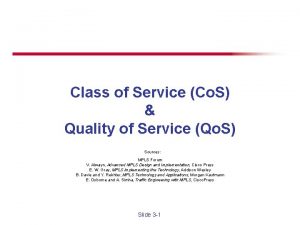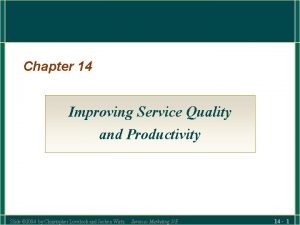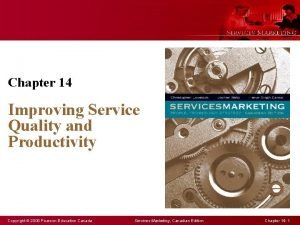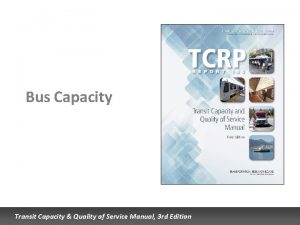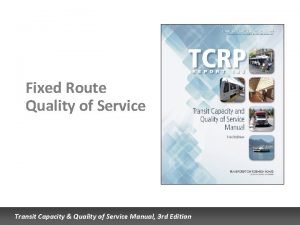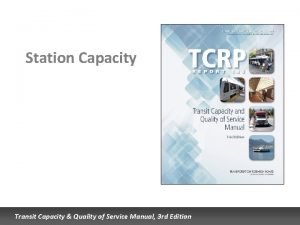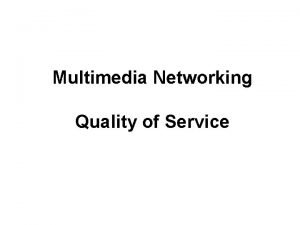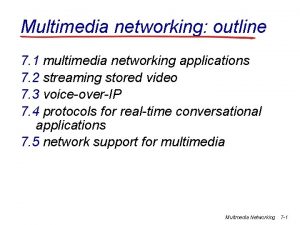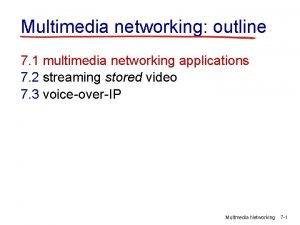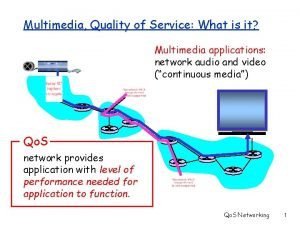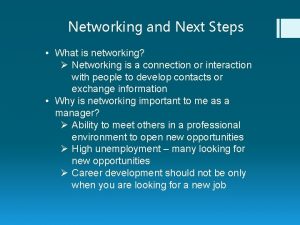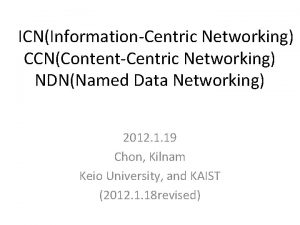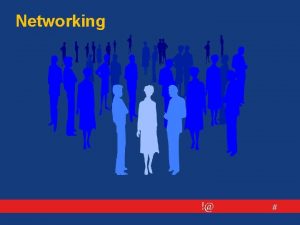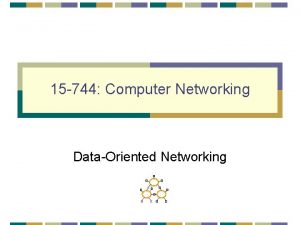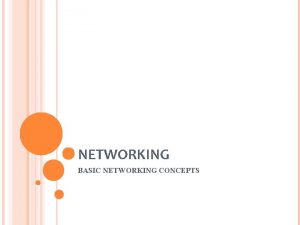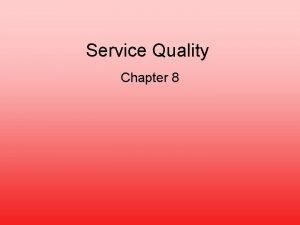19 Multimedia Networking Multimedia and Quality of Service



















- Slides: 19

19 – Multimedia Networking

Multimedia and Quality of Service: What is it? multimedia applications: network audio and video (“continuous media”) Qo. S network provides application with level of performance needed for application to function. Multimedia Networking 7 -2

MM Networking Applications Fundamental characteristics: • typically delay sensitive Classes of MM applications: 1) stored streaming 2) live streaming 3) interactive, real-time – end-to-end delay – delay jitter • loss tolerant: infrequent losses cause minor glitches • antithesis of data, which are loss intolerant but delay tolerant. Jitter is the variability of packet delays within the same packet stream Multimedia Networking 7 -3

Streaming Stored Multimedia Stored streaming: v media stored at source v transmitted to client v streaming: client playout begins before all data has arrived v timing constraint for still-to-be transmitted data: in time for playout Multimedia Networking 7 -4

Cumulative data Streaming Stored Multimedia: What is it? 1. video recorded 2. video sent network delay 3. video received, played out at client streaming: at this time, client playing out early part of video, while server still sending later part of video Multimedia Networking 7 -5 time

Streaming Live Multimedia Examples: • Internet radio talk show • live sporting event Streaming (as with streaming stored multimedia) • playback buffer • playback can lag tens of seconds after transmission • still have timing constraint Interactivity • fast forward impossible • rewind, pause possible! Multimedia Networking 7 -6

Real-Time Interactive Multimedia v applications: IP telephony, video conference, distributed interactive worlds • end-end delay requirements: – audio: < 150 msec good, < 400 msec OK • includes application-level (packetization) and network delays • higher delays noticeable, impair interactivity Multimedia Networking 7 -7

Multimedia Over Today’s Internet TCP/UDP/IP: “best-effort service” • no guarantees on delay, loss ? ? ? But you said multimedia apps requires Qo. S and level of performance to be ? effective! ? ? Today’s Internet multimedia applications use application-level techniques to mitigate (as best possible) effects of delay, loss Multimedia Networking 7 -8

Streaming Stored Multimedia application-level streaming techniques for making the best out of best effort service: – client-side buffering – use of UDP versus TCP – multiple encodings of multimedia Multimedia Networking Media Player • • 7 -9 jitter removal decompression error concealment graphical user interface w/ controls for interactivity

User Control of Streaming Media: RTSP HTTP • does not target multimedia content • no commands for fast forward, etc. RTSP: RFC 2326 • client-server application layer protocol • user control: rewind, fast forward, pause, resume, repositioning, etc… Multimedia Networking What it doesn’t do: • doesn’t define how audio/video is encapsulated for streaming over network • doesn’t restrict how streamed media is transported (UDP or TCP possible) • doesn’t specify how media player buffers audio/video 7 -10

RTSP: out of band control FTP uses an “out-of-band” control channel: • file transferred over one TCP connection. • control info (directory changes, file deletion, rename) sent over separate TCP connection • “out-of-band”, “in-band” channels use different port numbers Multimedia Networking RTSP messages also sent outof-band: • RTSP control messages use different port numbers than media stream: out-of-band. – port 554 • media stream is considered “in-band”. 7 -11

RTSP Example Scenario: • metafile communicated to web browser • browser launches player • player sets up an RTSP control connection, data connection to streaming server Multimedia Networking 7 -12

Metafile Example <title>Twister</title> <session> <group language=en lipsync> <switch> <track type=audio e="PCMU/8000/1" src = "rtsp: //audio. example. com/twister/audio. en/lofi"> <track type=audio e="DVI 4/16000/2" pt="90 DVI 4/8000/1" src="rtsp: //audio. example. com/twister/audio. en/hifi"> </switch> <track type="video/jpeg" src="rtsp: //video. example. com/twister/video"> </group> </session> Multimedia Networking 7 -13

RTSP Operation Multimedia Networking 7 -14

Content distribution networks (CDNs) Content replication • challenging to stream large files (e. g. , video) from single origin server in real time • solution: replicate content at hundreds of servers throughout Internet – content downloaded to CDN servers ahead of time – placing content “close” to user avoids impairments (loss, delay) of sending content over long paths – CDN server typically in edge/access network Multimedia Networking 7 -15 origin server in North America CDN distribution node CDN server in S. America CDN server in Europe CDN server in Asia

Content distribution networks (CDNs) origin server in North America Content replication • CDN (e. g. , Akamai) customer is the content provider (e. g. , CNN) • CDN replicates customers’ content in CDN servers. • when provider updates content, CDN updates servers CDN distribution node CDN server in S. America Multimedia Networking 7 -16 CDN server in Europe CDN server in Asia

HTTP request for www. foo. com/sports. html CDN example origin server 1 DNS query for www. cdn. com 2 CDN’s authoritative DNS server client 3 HTTP request for www. cdn. com/www. foo. com/sports/ruth. gif CDN server near client origin server (www. foo. com) • distributes HTML • replaces: http: //www. foo. com/sports. ruth. gif with http: //www. cdn. com/www. foo. com/sports/ruth. gif Multimedia Networking 7 -17 CDN company (cdn. com) v distributes gif files v uses its authoritative DNS server to route redirect requests

More about CDNs routing requests • CDN creates a “map”, indicating distances from leaf ISPs and CDN nodes • when query arrives at authoritative DNS server: – server determines ISP from which query originates – uses “map” to determine best CDN server • CDN nodes create application-layer overlay network Multimedia Networking 7 -18

Summary: Internet Multimedia: bag of tricks • use UDP to avoid TCP congestion control (delays) for time-sensitive traffic • client-side adaptive playout delay: to compensate for delay • server side matches stream bandwidth to available client-to-server path bandwidth – chose among pre-encoded stream rates – dynamic server encoding rate • error recovery (on top of UDP) – FEC, interleaving, error concealment – retransmissions, time permitting • CDN: bring content closer to clients Multimedia Networking 7 -19
 Sdn vs traditional network
Sdn vs traditional network Mpls class of service
Mpls class of service Quality control and quality assurance
Quality control and quality assurance Basic quality concepts
Basic quality concepts Linear and non linear multimedia examples
Linear and non linear multimedia examples Improving service quality and productivity
Improving service quality and productivity Service quality and productivity
Service quality and productivity Transit capacity and quality of service manual
Transit capacity and quality of service manual Transit capacity and quality of service manual
Transit capacity and quality of service manual Transit capacity and quality of service manual
Transit capacity and quality of service manual Pmp quality vs grade
Pmp quality vs grade What are quality standards in project management
What are quality standards in project management Ana model of quality assurance
Ana model of quality assurance Compliance vs quality
Compliance vs quality Gurus of total quality management
Gurus of total quality management Crosby quality is free
Crosby quality is free What is tqm
What is tqm Multimedia becomes interactive multimedia when
Multimedia becomes interactive multimedia when Csc253 interactive multimedia
Csc253 interactive multimedia Esa multimedia.esa.int./multimedia/virtual-tour-iss
Esa multimedia.esa.int./multimedia/virtual-tour-iss

